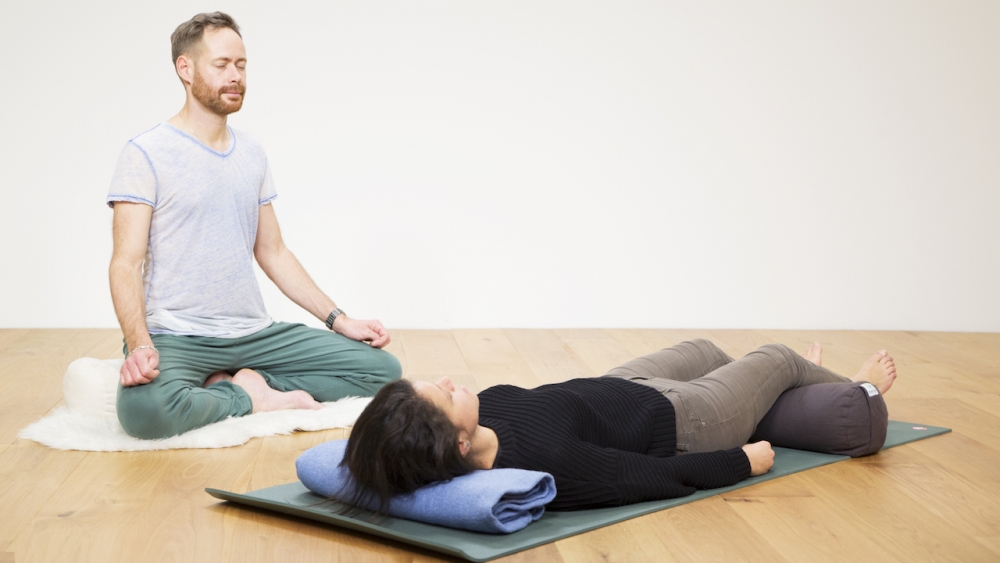Today, life is crazy-fast, and it’s becoming increasingly hard to switch off from not only work but also play. As we plug into social networks or engage in computer games and high-impact workouts, our leisure activities have become as stressful as our work.
We’re over stimulated, struggle to switch off, and are unable to truly rest. There are a lot of sleep-deprived souls out there right now!
So, thank goodness for Yoga Nidra: a leading-edge form of meditation that enables us to understand and exploit our ability to restore ourselves, at the deepest level and on every level: mind, body and soul. You will sleep better, master the art of napping, and you will learn how to navigate different sleep states in order to awaken, heal and nourish yourself.
How sleep and Yoga Nidra are related
The practice of Yoga Nidra brings us very close to sleep, enabling us to learn how to navigate it, and recognise when we are falling towards it. In time, we learn to stay conscious, therefore no longer ‘fusing’ our consciousness with sleep, so while our body rests and repairs, we can remain awake.
However, just like cannoning up to the edge of a waterfall, we might expect to go over the edge a few times until we really know where the edge is! You can expect to fall into sleep a few times before you master the art of staying alert through your Yoga Nidra practice.
Set an intention for your practice
At the very beginning of a Yoga Nidra session, we consider, or clarify, our intention for the practice. It might be to gain insight on an obstacle you are facing in your life, but in the beginning it may well be simpler – perhaps to feel rested and be restored. In this case, then falling asleep is just what we want and need! For the first 18 months or so of my own practice, Yoga Nidra was a doorway to an afternoon nap.
This became the resolution to a deep tiredness and exhaustion, and as I surrendered to this and regained my energy levels, I eventually found I could stay awake and aware through the whole practice.
Many of us are more tired than we recognise. If you are not getting 8+ hours of sleep a night it may be very necessary to restore your sleep debt first before you can stay awake and explore other intentions for your Yoga Nidra practice.
Once your sleep debt has been cleared, Yoga Nidra can become a powerful means of self-enquiry. Your intention might then be to meet a particular thought or emotion, or even to learn to concentrate your mind, and you will want to be sure to stay awake. Try practising at a point in the day when you feel energised, rather than depleted. This could be first thing in the morning, and it might also help to engage in some activity beforehand – perhaps you already have an energising asana (postures) or pranayama (breathing) practice.
We typically practise Yoga Nidra lying down, therefore one trick to stay awake is to keep a forearm off the floor so that as your body falls asleep, your arm sinking to the floor alerts you to this. You could also consider sitting up, or even standing up for the practice. Not only will this help keep you more alert but it will resolve the tendency to make experiences state specific, such as that you can relax and find peace lying on the floor but in waking life you lose that sense of calm.
If you are curious about Yoga Nidra, join me in my Yoga Nidra program, where I will introduce and guide you through different aspects of this practice.
Understanding hypnopompic and hypnagogic sleep
The in-between places
If we do happen to fall asleep or drift in and out of sleep in our Yoga Nidra practice then we might begin to be able to observe our consciousness resurfacing.
As we emerge from sleep we enter the hypnopompic state. Here we can watch as the structures of our sense of self, me or I arise. We then observe our thoughts, beliefs, and memories as they reform on the surface of our Awareness. That is to say, that we experience, even if fleetingly, the very deepest state that precedes the mind and thoughts: beyond the mind and the identity of ego is pure, open, spacious Awareness. In this state, we no longer have to take it from somebody else, from the high teachers, but in our own experience, however fleetingly, that we are this openness of consciousness. We experience who we are at our deepest level.
With more practise and more insight, we begin to recognise the pre-sleep hypnagogic state. Here we ride a threshold between the conscious mind and cognition and the unconscious mind and memory. You may well be familiar with that sense of falling we experience in this state (called myoclonic jerks) and we may experience hypnagogic elucidations, where we enter a kind of daydream.
Throughout history artists and scientists alike have reported of the insights that come from resting in this between-sleep place. Edgar Allan Poe, for example, wrote of the “fancies” he experienced, “only when I am on the brink of sleep, with the consciousness that I am so,” and the chemist August Kekulé discovered the ring structure of benzine whilst dozing, literally seeing atoms dancing before his eyes, falling in to snakes, until one of the snakes took hold of its own tail.
Beta and alpha waves
In many ways, this state is akin to meditation: the brain shifts from producing beta waves (the waking mind, cognition) to alpha waves (slow thinking and space between thoughts). The difference is that we’ve dropped effortlessly towards this state and in fact, we can’t avoid it; it happens every time we go to sleep. It’s just that with Yoga Nidra we are able to pay attention and learn to not ‘fuse’ this state with the sleep state.
The stages of sleep
Once we pass through the doorway of the hypnagogic state, we enter into stages 1 and 2 of sleep. The benefits of these are most commonly associated with the qualities of a ‘power nap’: increased creativity and problem-solving, reduced sleepiness, heightened alertness and an elevated mood. Assuming we don’t doze for any more than 18-20 minutes, we can expect to get all of these benefits without feeling groggy.
However, if we move beyond this 20-minute threshold, the body moves into the deeper sleep states that mobilise and activate repair mechanisms. The mind is cleared of unwanted information, tissue repair takes place, and metabolism kicks in. The downside is that if you are woken during this phase of sleep you will likely feel dazed, tired and a bit grumpy! Therefore it is best to try to complete the sleep cycle (about 90 minutes), and indeed ensure your night-time sleep totals a number of complete sleep cycles, ensuring you wake up fresh for the start of your day.
Rapid Eye Movement (R.E.M.) sleep tends to occur towards the end of these cycles, completing the 5 stages of sleep. We get much more REM sleep at the end of a full night as the body has completed much of its repair in earlier sleep cycles, which is why you often experience and recall your dreams in the morning time and you might not dream so much in an afternoon nap.
Our intention in Yoga Nidra is to remain aware of all of these stages of sleep.
You may become more conscious of the dream state and find you can remember more of your dreams. With time and practise, you can feel how the body goes to sleep, and moves through the stages of sleep, and you can learn to stay conscious and sentient throughout these stages. There are even people who report they ‘don’t sleep a wink’ all night yet when they are monitored in sleep labs it is discovered that their bodies are indeed moving through the stages of sleep and associated repair – such people are natural Yoga Nidra meditators!
Using Yoga Nidra to get to sleep
Yoga Nidra can be used to get yourself to sleep at night, or to fall back to sleep if you have awoken. Many people report a deeper, more rested sleep as a result of using the practice in this way. It is an excellent way of easily integrating Yoga Nidra into your day, and it’s a wonderful skill to have. If you were to go too long without sleep you would begin to lose your sanity. We need sleep like we need air and water.
However, we want our Yoga Nidra practice to work on a more profound level too: to enable us to utilise the various different stages of sleep to then experience ourselves as the one who is aware of all states: waking, dreaming and deep sleeping. It is a popular misconception that we take in new information and learn whilst asleep, so to go beyond using Yoga Nidra as means to feel more rested, you have to practise awake!
The teachings of Buddhism often refer to sleep as an enemy in meditation, but I recently happened upon a great quote:
You must decide for yourself, are you going to snuggle, or stay awake? Both have their merits. Most of all, I hope you have a wonderful time exploring this practice and resting deeply. It’s worth doing nothing and having a rest!
Related reads
Yoga Nidra Teacher Training with James Reeves – EkhartYoga Academy
Get in touch with your true nature and deepest desires, while better understanding the human experience using the tools of Yoga Nidra.
In this comprehensive online course you’ll receive step by step guidance, scripts and audio practices, plus detailed practical techniques to support you in becoming a Yoga Nidra teacher. This course is equally suitable for non-teachers as a personal development course. Learn more on the EkhartYoga Academy.



